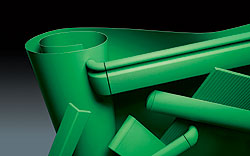Green Products: Trends & Innovations
Eliminating Volatile Organic Compounds
The release of the USGBC draft report Assessment of Technical Basis for a PVC-Related Materials Credit in LEED, and the council's refusal to take action on the PVC issue has created a tumult among its membership.
In its most recent newsletter, the Healthy Building Network (HBN), a national network of green building professionals, environmental and health activists, castigated the council for its failure to ban building products with that contain polyvinylchloride, which, when burned, is a source of dioxins.
"PVC wasn't on the radar screen until LEED began its assessment," says Howard Williams, General Manager of the Cranford, N.J.-based C/S Group of Companies, formerly Construction Specialties Inc. "We recognized the problems associated with PVC in 1964. Our customers (the list includes Kaiser Permanente and other hospitals, Williams says) have told us they don't want it, and we will not debate that."
|
A growing number of manufacturers are moving away from PVC-based and V.O.C. (volatile organic compounds)-emitting materials. Some of the changes are driven by LEED, others by heightened owner awareness that "healthy" buildings make economic sense.
Williams says the C/S Group abides by what he terms "The Precautionary Principle: if you have any doubt about a product, don't use it."
Wallcoverings, handrails, crashrails and corner guards, manufactured from harvested bamboo and FSC-certified wood, are PVC-free, and come with waterborne, V.O.C.-free finishes.
These products are now powder-coated, in an electrostatic process that eliminates the troublesome odor commonly associated with new paint.
"LEED rewards environmentally friendly materials with low-emitting paints and coatings," Williams says. "We search the world for better products."
Much of what LEED mandates today, C/S learned long ago, Williams says−that the benefits of sun controls reduce heat and glare, lowering a building's overall energy costs and increasing worker productivity; that permanent 12 to 18-foot mats at high-traffic building entrances can stop 98 percent of dirt from entering and reduce cleaning by up to 50 percent.
"Architects are probably saying to themselves today ‘Product manufacturers are finally starting to get it,' " he says.










